Life Cycle Approach to Shopping Mall Redevelopment: A Model for Service Life Design
Abstract
1. Introduction
1.1. Theoretical Background and Research Motivation
1.2. Methodological Outline and Case Application
2. Materials and Methods
- Theoretical Foundation: Contemporary theoretical foundations concerning the typology and challenges of shopping malls—as specific architectural and commercial entities—are presented through the theory of the “ideal shopping mall.” Success criteria are defined and categorized into four thematic groups: location, market context, architectural design, and facility management. These success factors are further analyzed using a set theory-based mathematical model to interpret architectural relationships. The conceptual basis, presented through the definition of building life cycle stages that integrate LCA and SLP principles, introduces the field of redevelopment and the alignment with defined quality requirements.
- Classification of Degradation and Risk Factors: This component addresses the identification of key sustainability disruption factors, which serve as input variables in the predictive modeling process.
- Case Study Application and Validation: The proposed hybrid model is tested on a real-world case study—shopping mall “Deva 1” in Serbia—through the quantitative verification of condition assessment and service life prediction using the Markov chain model. The methodology includes the collection and verification of input data, definition of the baseline (zero) condition, assessment of mechanical and physical performance of construction materials, tracking material property changes over time, structural analysis, and proof of load-bearing capacity and usability. Predictive model outputs are then used to define the projected service life.
2.1. Theory of Ideal Shopping Malls (SMs)
- Location—Accessibility of the facility, involving studies on demographic gravity, availability, competition, and target groups.
- Architecture and interior design—Refers to the architectural form of the building, lighting and climate control systems, interior design and decoration, andlandscape design.
- Leasing strategy—Selection of anchor and satellite tenants, and the proportion of space leased to each.
- Tenant mix and clustering potential [22]—roping of stores with linked procurement and sales strategies, optimal spatial distribution of retail units, and Central Management (CM) operations.
Classification of SM Success Factors According to Sonae Sierra (SS)
2.2. Product Life Cycle of an SM—LPSC
- Planning, design, and construction of the shopping center;
- Revenue growth, with the generation of peak income;
- Maturity, when revenues stabilize and remain constant;
- Saturation, marked by declining sales;
- Revitalization/redevelopment (reinvestment);
- (a)
- “Restoring momentum” by returning to an earlier phase of revenue growth;
- Degeneration, when the SM can no longer be reactivated or operate profitably;
- (a)
- Market exit, involving the permanent closure of the shopping center.
Building Life CyclePhases—BLC
- Production phase (A1–A3): Covers raw material extraction, transportation, and manufacturing of construction materials.
- Construction phase (A4–A5): Involves transportation of materials to the construction site and the actual building process.
- Use phase (B1–B7): Encompasses building operation, including energy and water consumption, maintenance, repairs, replacements, and renovations throughout its service life.
- End-of-life phase (C1–C4): Includes deconstruction, waste transport, waste processing, and final disposal.
- Additional phase (D): An optional phase that considers potential benefits from recycling and reuse of materials beyond the system boundaries [28].
2.3. Redevelopmentof Shopping Malls—Renewal Cycle and the Level of Compliance with SM Requirements
Success Factors in SM Operations and the Enhancementof Stakeholder Interaction—Strategic Planningfor Renewal, Reinvestment, and Revitalization
- Investors and owners: A clear vision and adequate investment are essential. Owners must establish long-term goals and ensure the availability of financial resources.
- Architects and designers: Play a key role in enhancing the esthetic and functional qualities of the facility.
- Leasing departments: Responsible for identifying suitable tenants and positioning the revitalized center on the market.
- Tenants and brands: Selecting high-quality tenants aligned with the target audience is crucial.
- Marketing professionals: Communicating changes and the new brand identity is vital for attracting customers.
- Technology partners: Integration of Wi-Fi networks, mobile applications, and digital signage can significantly enhance the shopping experience.
- Innovative center management companies: Ensure professional operation and (re)positioning of the center through innovative strategies.
- Data processing and analysis of the current condition and need for SM revitalization,
- Market research as the basis for adaptation to market demands;
- Potential recomposition of the SM, including Due Diligence (DD) procedures that regulate core rights and financial aspects within facility management;
- Facility management (FC) in accordance with IFMA (International Facility Management Association) standards, focusing on preventive actions and the implementation of revitalization and safety strategies [1].
- Integration with surrounding urban flows, such as pedestrian zones, parks, and marketplaces;
- Conversion into mixed-use programs, including residential–commercial, cultural, and educational facilities;
- Rebranding through design, incorporating natural materials, green roofs, openness, and natural lighting;
- Energy efficiency and sustainability, in alignment with international certification standards such as BREEAM and LEED [32].
2.4. Integrated Design Models ofanSM Based on the Life Cycle Approach in the Cotext of Sustainable Construction
2.4.1. Monitoring of Building Condition
2.4.2. Architectural Structure System
2.4.3. Material Durability
2.5. Service Life Planning-Based Concept(SLP)
2.5.1. Estimated Service Life (ESL) Structure or Structure Element
- The definition of the relevant limit state;
- A time period expressed in years;
- The reliability level that the limit state will not be reached within that period.
2.5.2. Correlation Between Technical, Functional and Economic Service Life
2.6. Application of LCA Methodology in the Design, Monitoring, and Extension of SM Service Life
3. Discussion and Results
3.1. Basic Hybrid Model—Action of Integrated Design for the Remodeling of SM Buildings
Requirements, Degradation Causes, and Objectives of Sustainable Construction
3.2. Decision-Making (DM) on the Final Outcome of the Remodeling Action of the Building
| No. | Structural Material | Index of Relative Energy Consumption |
|---|---|---|
| 1 | Timber | 1 |
| 2 | Concrete | 3 |
| 3 | Steel | 17 |
| 4 | Aluminum | 70 |
| No. | Structural Material | Index of Relative Carbon Emission |
|---|---|---|
| 1 | Timber | 1 |
| 2 | Concrete | 8 |
| 3 | Steel | 21 |
| 4 | Aluminum | 264 |
3.3. Durability and Safety Requirement
3.4. Case Study Results—SM “Deva 1” Kruševac, Serbia
| Condition Assessments | Description | Demage Percentage |
|---|---|---|
| 1 | Excellent | 0–10% |
| 2 | Very Good | 11–25% |
| 3 | Good | 26–40% |
| 4 | Fair | 41–55% |
| 5 | Poor | 56–70% |
| 6 | Very Poor | 71–85% |
| 7 | Faile | More than 85% |
3.4.1. Input Data and Methods
3.4.2. Output Data and Conclusion
4. Conclusions
- Reliable quantitative assessment of building service life over time;
- Identification of critical moments for intervention;
- Evaluation of maintenance effects in contrast to a passive “do-nothing” scenario;
- Informed decision-making in the design of future redevelopment strategies.
Author Contributions
Funding
Institutional Review Board Statement
Informed Consent Statement
Data Availability Statement
Conflicts of Interest
Abbreviations
| SM | Shopping Mall |
| LCA | Life Cycle Assessment |
| SLP | Service Life Planning |
References
- Tamburić, J. Shopping Centers Remodeling—The Form and the Concept of Improving Architectural Characteristics of Buildings. Doctoral Dissertation, University of Niš, Faculty of Civil Engineering and Architecture, Niš, Serbia, 2018. [Google Scholar]
- Çavka, H.B. An Investigation of Shopping Mall Design Requirements. Eng. Proc. 2023, 53, 42. [Google Scholar] [CrossRef]
- Spencer, L. The Great American Shopping Mall: Past, Present, and Future. 2021. Available online: https://live-journal-of-law-and-public-policy.pantheonsite.io/?p=3745 (accessed on 15 April 2025).
- Kelly, K. Global Mall Development Trends. 2018. Available online: https://kk.org/extrapolations/global-mall-development-trends/ (accessed on 10 April 2025).
- Capital One Shopping Team. Mall Closure Statistics. 2025. Available online: https://capitaloneshopping.com/research/mall-closure-statistics (accessed on 16 April 2025).
- Peneder, R. The next generation of shopping centres. SHOP Aktuell 2011, 109, 6–13. [Google Scholar]
- Živković, M. Defining and Applying the Method for Evaluating the Flexibility of Spatial Organization of the Flat in Multi-Family Residential Buildings. Doctoral Dissertation, University of Niš, Faculty of Civil Engineering and Architecture, Niš, Serbia, 2017. Available online: https://nardus.mpn.gov.rs/handle/123456789/9435 (accessed on 8 March 2025).
- White, J.T.; Orr, A.; Jackson, C. Averting dead mall syndrome: De-malling and the future of the purpose-built shopping center in large UK cities. J. Urban Aff. 2023, 47, 1523–1539. [Google Scholar] [CrossRef]
- Sierra, S. The Science of Positioning Real Estate Assets to Achive Full Potential. 2025. Available online: https://www.sonaesierra.com/wp-content/uploads/2023/03/CS-The-science-of-positioning-FV.pdf (accessed on 16 March 2025).
- GMA; Sierra. Shoppingcenter-Revitalisierung in Deutschland; Sonae Sierra: Düsseldorf, Germany, 2011; Available online: https://www.sonaesierra.com/wp-content/uploads/2022/06/a0be46d3-da00-4e22-8cdf-77ac4538c727.pdf (accessed on 27 February 2025).
- ISO14044:2006a; Environmental Management—Life Cycle Assessment—Requirements and Guidelines, 1st ed. WHO: Geneva, Switzerland, 2006.
- EN 15978:2011; Sustainability of Construction Works. Assessment of Environmental Performance of Buildings. Calculation Method. SIST—Slovenian Institute for Standardization: Ljubljana, Slovenia, 2011.
- ISO 15686 Series; Factor Method for the Assessment of Service Life Planning. WHO: Geneva, Switzerland, 2014.
- Poderytė, I.; Banaitienė, N.; Banaitis, A. Life Cycle Sustainability Assessment of Buildings: A Scientometric Analysis. Buildings 2025, 15, 381. [Google Scholar] [CrossRef]
- Schmidtke, T. Trend zur Revitalisierung von Shopping-Centern in Deutschland. Ph.D. Thesis, University of Applied Sciences, Mittweida, Germany, 2011. Available online: https://monami.hs-mittweida.de/frontdoor/deliver/index/docId/2034/file/Trend_zur_Revitalisierung_von_Shopping_Centern_in_Deutschland.pdf (accessed on 25 February 2025).
- Zahoor, M.H.; Ali, M. Assessment of Critical Success Factors for Building Projects through the Literature. In Proceedings of the1st International Online Conference on Buildings, Online, 24–26 October 2023. [Google Scholar] [CrossRef]
- Amini Toosi, H.; Lavagna, M.; Leonforte, F.; Del Pero, C.; Aste, N. Life Cycle Sustainability Assessment in Building Energy Retrofitting: A Review. Sustain. Cities Soc. 2020, 60, 102248. [Google Scholar] [CrossRef]
- Asdrubali, F.; Fronzetti Colladon, A.; Segneri, L. LCA and energy efficiency in buildings: Mapping more than twenty years of research. Energy Build. 2024, 321, 114684. [Google Scholar] [CrossRef]
- Di Santo, N.; Henriquez, L.G.; Dotelli, G.; Imperadori, M. Holistic Approach for Assessing Buildings’ Environmental Impact and User Comfort from Early Design: A Method Combining Life Cycle Assessment, BIM, and Active House Protocol. Buildings 2023, 13, 1315. [Google Scholar] [CrossRef]
- Cao, J.; Zhu, Y.; Zhang, J.; Wang, H.; Zhu, H. The Sustainability Study and Exploration in the Building Commercial Complex System Based on Life Cycle Assessment (LCA)–Emergy–Carbon Emission Analysis. Processes 2023, 11, 1989. [Google Scholar] [CrossRef]
- Lange, C. Fallstudien zur gebauten Realität in Deutschland-Dissertation. Doctoral Dissertation, Technischen Universität Berlin, Fakultät VI, Planen Bauen Umwelt, Berlin, Germany, 2008. [Google Scholar]
- Back, N. Future Strategies of Shopping Center Investors & Developers in Germany How to Compete with E-Commerce? Master’s Thesis, Ebs Business School Ebs Universität Für Wirtschaft und Recht & Nova School of Business and Economics Universidade Nova De Lisboa, Frankfurt, Germany, 2019. Available online: https://run.unl.pt/bitstream/10362/92320/1/Back_2019.pdf (accessed on 11 March 2025).
- ISO2394:2015; General Principles on Reliability for Structures. WHO: Geneva, Switzerland, 2015.
- EN 1990:2002/Al:2005; Eurocode 0, Basis of Structural Design. European Committee for Standardization: Brussels, Belgium, 2005.
- Reikli, M. Composing Elements of Shopping Centers and Their Strategic Fit. Doctoral dissertation, Corvinus University of Budapest, Budapest, Hungary, 2012. [Google Scholar]
- Weis, H.C. Marketing-Kompendium der Praktischen Betriebswirtschaft, 16th, Improved and Updated ed.; NWB Verlag: Kiehl, Germany, 2012. [Google Scholar]
- Ziercke, C. Strategien zur Revitalisierung von Shopping-Centern. Ph.D. Thesis, Fakultät Wirtschaft und Recht/Immobilienwirtschaft, Hamburg, Germany, 2003. [Google Scholar]
- Wood Works. Introduction to Whole Building Life Cycle Assessment: The Basics. 2025. Available online: https://www.woodworks.org/wp-content/uploads/expert-tips/expert-tips_introduction-to-whole-building-life-cycle-assessment-the-basics.pdf (accessed on 5 March 2025).
- Parasonis, J.; Kiefel, M.-I.; Liu, G.; Michel, S.; Nolte, I.; Potapova, A.; Protz, R.; Müller-Zinsius, H.; Gebauer, K.; Ryslavy, N.; et al. Building Life Cycle. In Longlife 2. Development of Standards, Criteria, Specifications, Economical and Financial Models, Assessment of Sustainability, Life Cycle and Operating Costs; Universitätsverlag der TU Berlin: Berlin, Germany, 2010. [Google Scholar]
- André, S. Revitalization and Assessment of Retail Real Estate: Case Study of Rathaus Galerie Essen. Available online: https://www.across-magazine.com/revitalization-and-assessment-of-retail-real-estate-case-study-of-rathaus-galerie-essen/ (accessed on 16 April 2025).
- Urbano, E. Reinvention through design. ArchDaily, 29 December 2017. [Google Scholar]
- Pilgreen, T.; Plenge, A. Reinventing the Mall Developers Are Transforming Struggling Malls into Thriving Urban Lifestyle Centers. Available online: https://www.gensler.com/dialogue/35/reinventing-the-mall (accessed on 6 March 2025).
- Tamburić, J.; Stojić, D.; Nikolić, V. Service life and durability of architectonic structures. FACTA Univ. Ser. Archit. Civ. Eng. 2016, 14, 275–284. [Google Scholar] [CrossRef]
- Mohammadi, S. Flexibility as Foundation of Sustainability; Draaijer + Partners, TU Delft, Faculty of Architecture: Delft, the Netherland, 2010. [Google Scholar]
- Ritter, F. Lebensdauer von Bauteilen und Bauelementen-Modellierung und Praxisnahe Prognose. Doctoral Dissertation, Technische Universität Darmstadt Institut Für Massivbau, Darmstadt, Germany, 2011. [Google Scholar]
- Kalusche, W. Technische Lebensdauer von Bauteilen und wirtschaftliche Nutzungsdauer eines Gebäudes. In Bauen, Bewirtschaften, Erneuern—Gedanken zur Gestaltung der Infrastruktu; vdf Hochschulverlag an der ETH Zürich: Zürich, Switzerland, 2004; pp. 55–71. [Google Scholar]
- Sonae, S. ParkLake: Putting Sustainability at the Heart of the Shopping Centre. 2018. Available online: https://www.sonaesierra.com/wp-content/uploads/2023/01/ParkLake_Putting_sustainability_at_the_heart_of_-the_shopping_centre.pdf#:~:text= (accessed on 6 March 2025).
- Sarja, A. Generalised lifetime limit state design of structures. In Proceedings of the Second International Conference on Lifetime-Oriented Design Concept, Bochum, Germany, 1–3 March 2004. SFB 398. [Google Scholar]
- BMVBS. Leitfaden Nachhaltiges Bauen; Bundesministerium für Verkehr, Bau und Stadtentwicklung: Berlin, Germany, 2011. [Google Scholar]
- Sarja, A. Integrated Life Cicle Design of Material and Structural Design. In Proceedings of the ILCDES 2000 RILEM, AFCE, Helsinki, Finland, 20–24 May 2000. [Google Scholar]
- Lounis, Z.; Lacasse, M.; Vanier, D.; Kyle, B.R. Towards Standardization of Service Life Prediction of Roofing Membranes. In Proceedings of the Roofing Research and Standards Development, Nashville, TN, USA, 6 December 1998. [Google Scholar] [CrossRef]
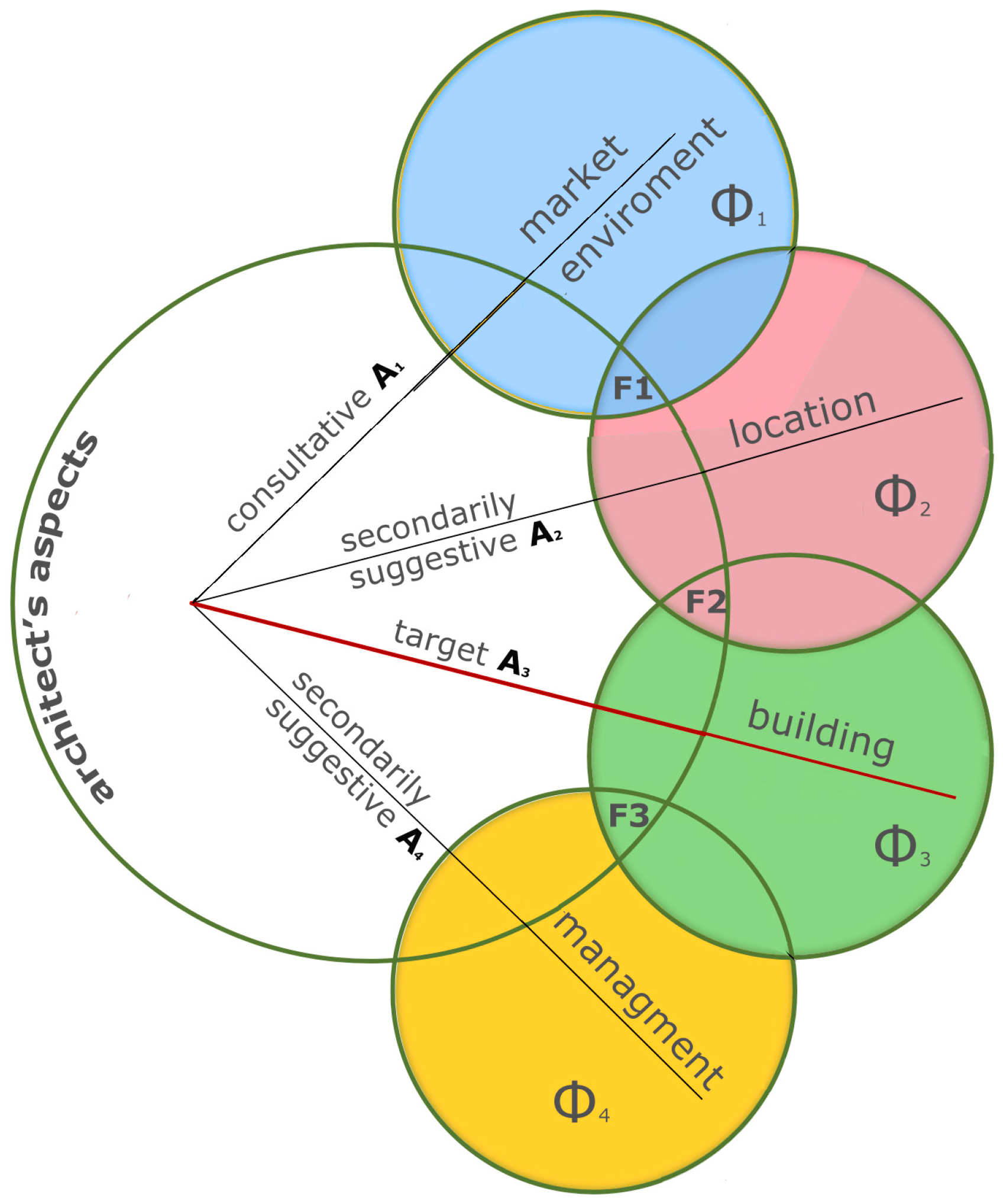


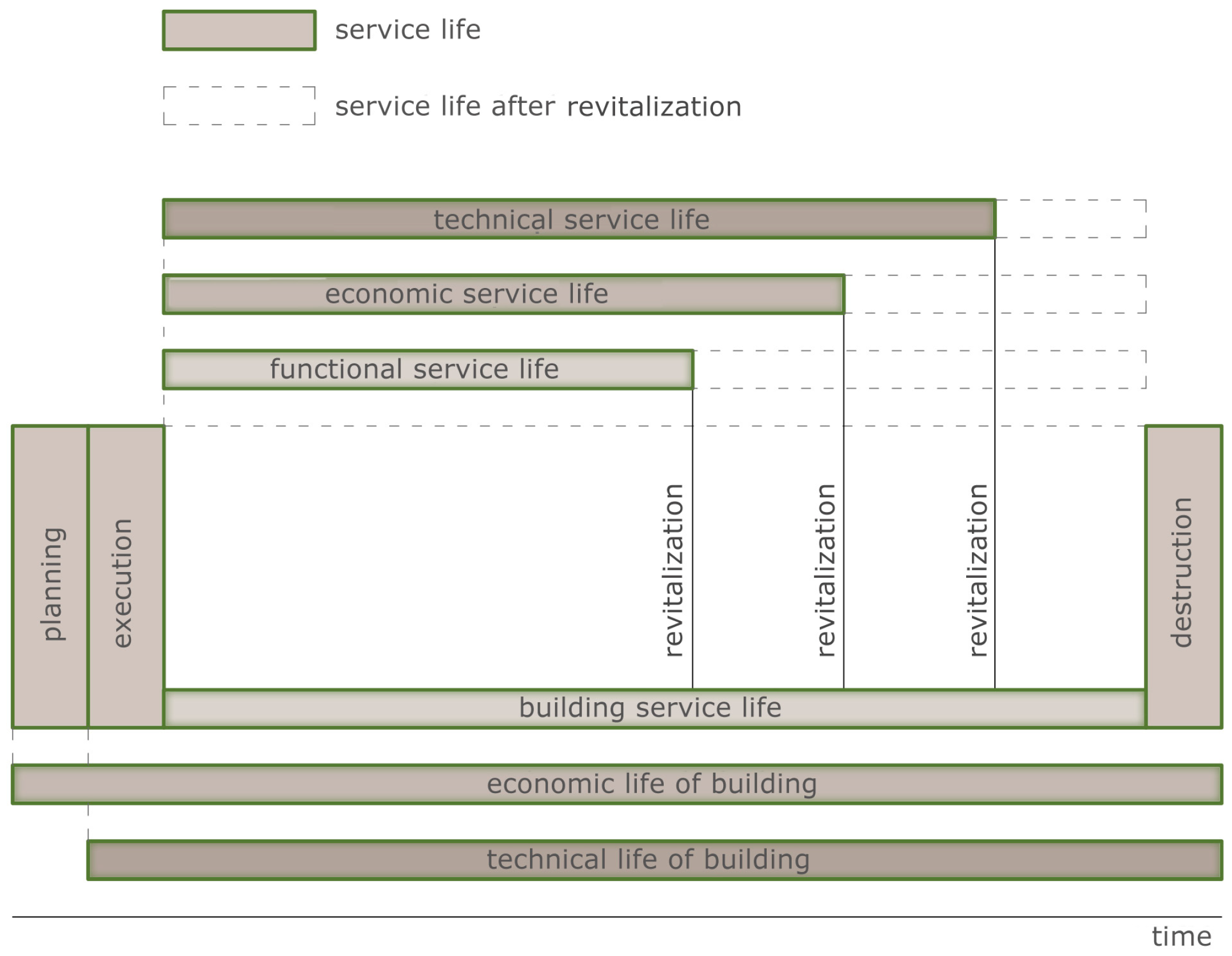
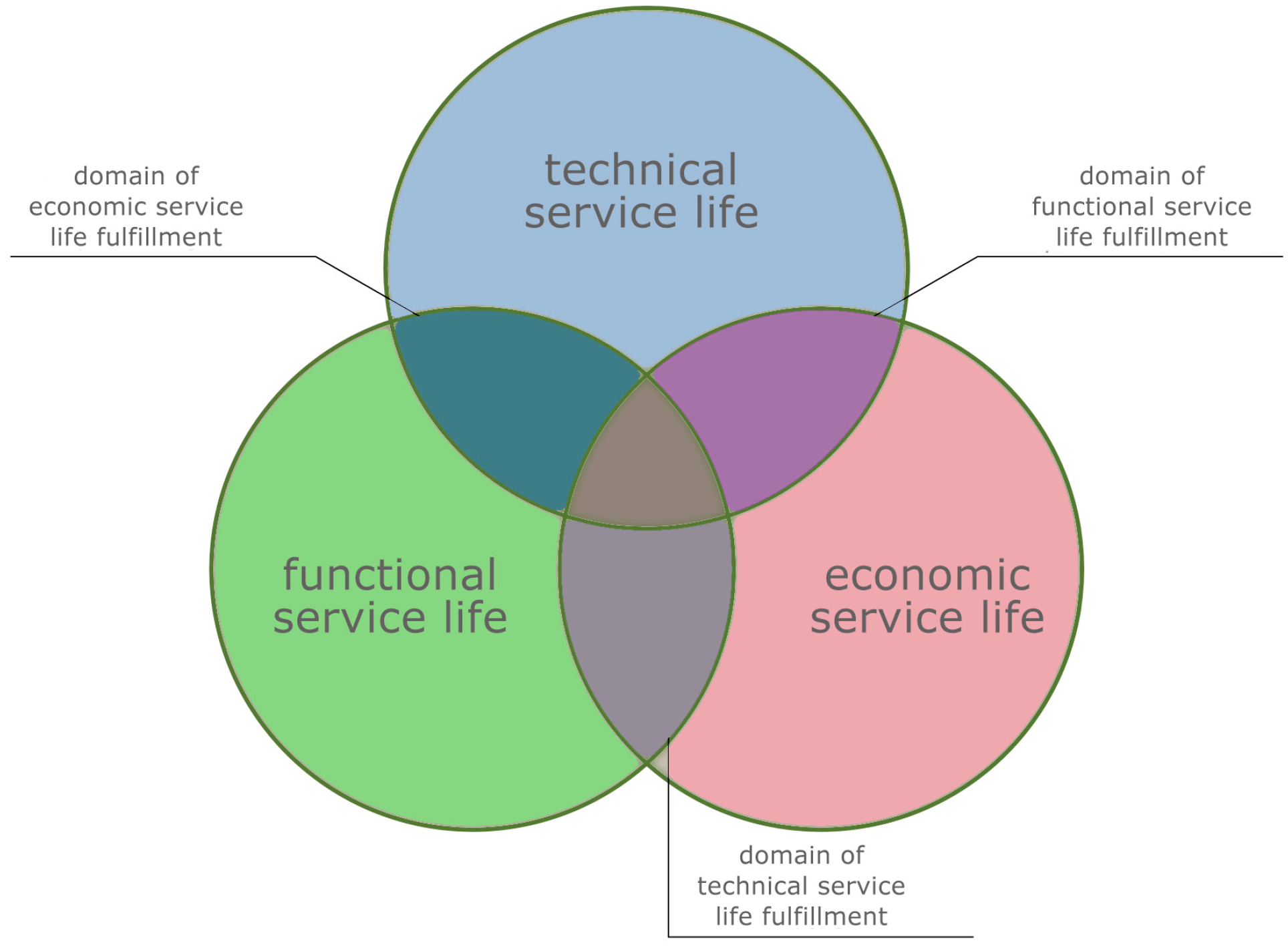
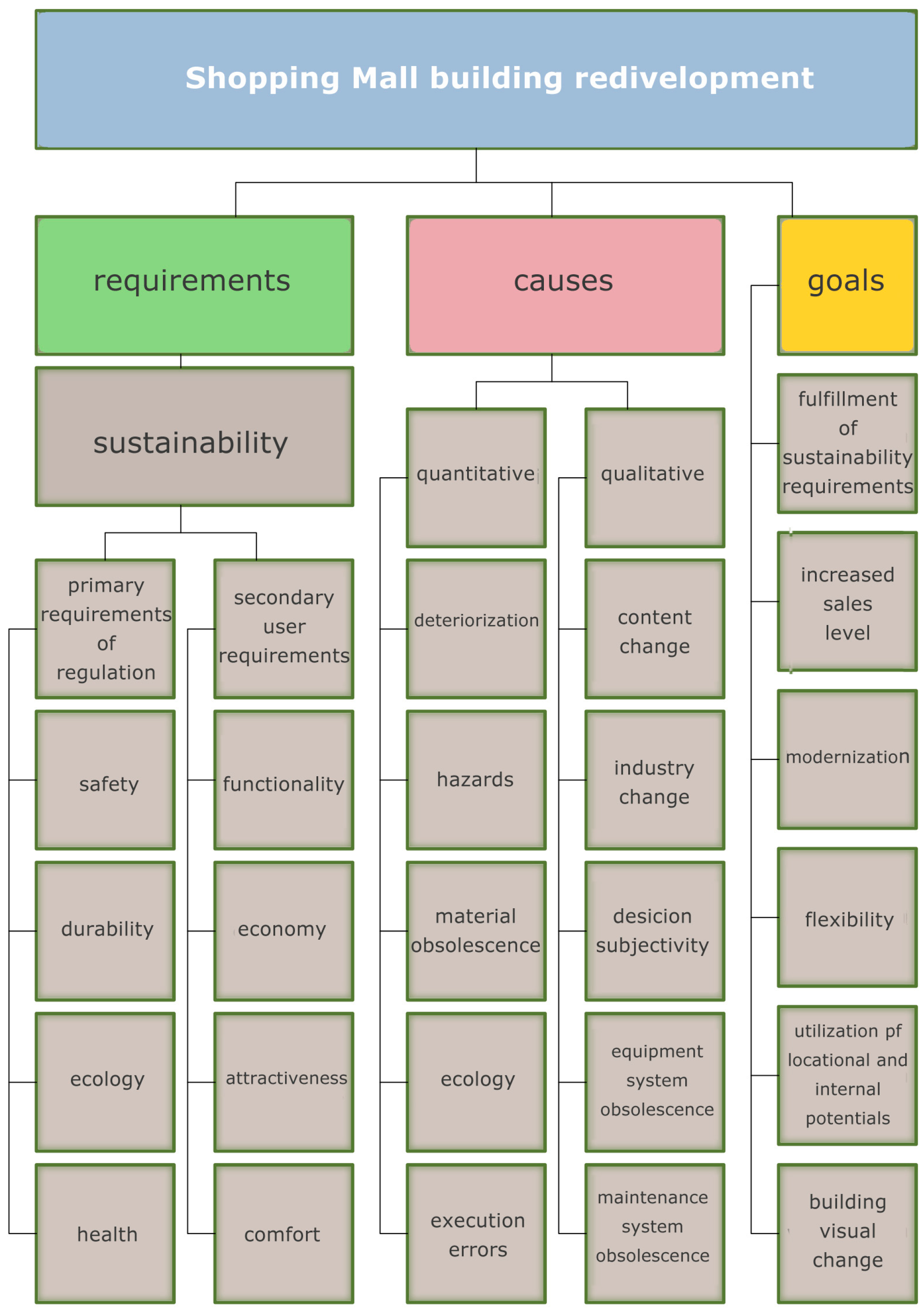

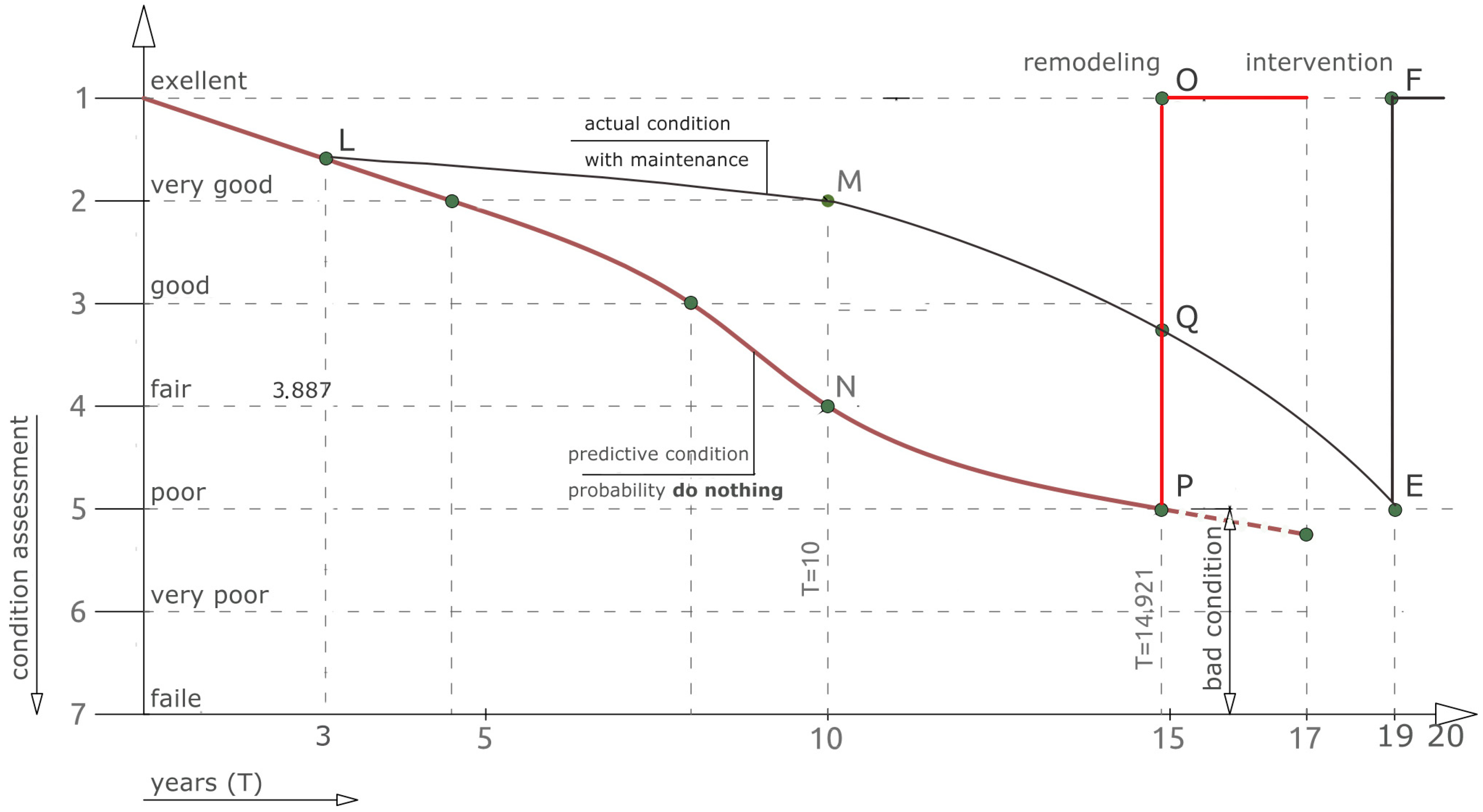
| Success Criteria of Shopping Malls | Category Ф | Influential factors F | Architect’s Aspects A |
|---|---|---|---|
| Demographics and Socio-economics | Market environment Ф1 | Independent factors F1 | Consultative aspect A1 |
| Competition | |||
| Gravitational area | Conditional factors F2 | ||
| Micro-location | Location Ф2 | Secondarily suggestive aspect A2 | |
| Traffic accessibility | |||
| Building size | Building Ф3 | Target aspect (crucial in developing redevelopment alternatives) A3 | |
| Number of floors | |||
| CLC (center layout concept)—structure, functionality, esthetics | Direct factors F3 | ||
| Condition of the structure, facade, and visible interior surfaces | |||
| Adjustment of tenant mix and sectors | |||
| Management quality | Management Ф4 | Secondarily suggestive aspect A4 | |
| Brands IT infrastructure |
| Condition Si | tk—Time Corresponding to Condition Si | T(i+1)—Duration of Condition Si |
|---|---|---|
| S1 | tk (1) | 0 do T2 |
| S2 | tk (2) | T2 do T3 |
| S3 | tk (3) | T3 do T4 |
| S4 | tk (4) | T4do T5 |
| S5 | tk (5) | T5 do T6 |
| S6 | tk (6) | T6 do T7 |
| S7 | tk (7) | T7 |
Disclaimer/Publisher’s Note: The statements, opinions and data contained in all publications are solely those of the individual author(s) and contributor(s) and not of MDPI and/or the editor(s). MDPI and/or the editor(s) disclaim responsibility for any injury to people or property resulting from any ideas, methods, instructions or products referred to in the content. |
© 2025 by the authors. Licensee MDPI, Basel, Switzerland. This article is an open access article distributed under the terms and conditions of the Creative Commons Attribution (CC BY) license (https://creativecommons.org/licenses/by/4.0/).
Share and Cite
Tamburić, J.; Nikolić, V.; Stojić, D.; Nikolić, O. Life Cycle Approach to Shopping Mall Redevelopment: A Model for Service Life Design. Appl. Sci. 2025, 15, 7509. https://doi.org/10.3390/app15137509
Tamburić J, Nikolić V, Stojić D, Nikolić O. Life Cycle Approach to Shopping Mall Redevelopment: A Model for Service Life Design. Applied Sciences. 2025; 15(13):7509. https://doi.org/10.3390/app15137509
Chicago/Turabian StyleTamburić, Jasmina, Vladan Nikolić, Dragoslav Stojić, and Olivera Nikolić. 2025. "Life Cycle Approach to Shopping Mall Redevelopment: A Model for Service Life Design" Applied Sciences 15, no. 13: 7509. https://doi.org/10.3390/app15137509
APA StyleTamburić, J., Nikolić, V., Stojić, D., & Nikolić, O. (2025). Life Cycle Approach to Shopping Mall Redevelopment: A Model for Service Life Design. Applied Sciences, 15(13), 7509. https://doi.org/10.3390/app15137509






